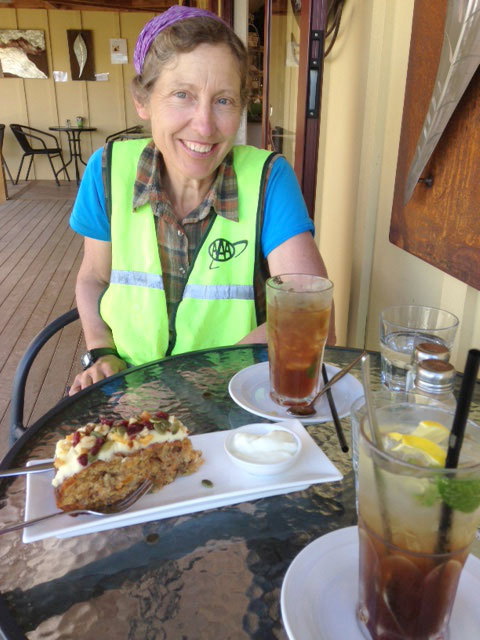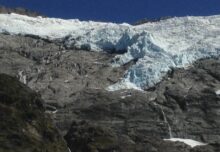
 A long ride on the Central Otago Rail Trail
A long ride on the Central Otago Rail Trail
For a long-distance cyclist, 150 miles of scenic, almost flat road cleared of cars and trucks is a dream ride. Add in roadside cafes that serve tea and carrot cake, quaint old taverns with jolly bartenders, and gold mining ghost towns to make the ride even more fun. We smiled almost every moment of the four days we were riding the Central Otago Rail Trail.
The last train chugged along the tracks in Central Otago in 1990. This remote, dry part of the South Island is a place of big sheep farms and little villages. Since its gold rush in the 1880s, the region has depopulated but the rail trail has put the area back on the map. Some parts of the trail get over 20,000 riders a year, enough to keep taverns open and add new businesses like bed and breakfasts and bike touring companies.
The western end of the trail starts in Clyde, a former gold mining town with a revived Main Street and a small museum with a chatty director. I hadn’t known that the Gold Rush in New Zealand (which began in the 1860s) was a big one, like the California, Alaska, and Australian gold rushes before it.
As we rode along the Clutha River we could see the dredging from the Gold Rush, part 2. In the twentieth century the river sands were re-worked using a better crushing technique and mercury to bind small pieces of gold.
We spent the night in Alexandra at a holiday park (a campground with a few extras like a kitchen with boiling water on tap, Kiwis must have their tea) and headed out onto the trail in the early morning. We had been warned that the trail could be hot and windy but our first morning it was cool and we were charmed by the rock formations and the little rail stations, now filled with signs telling bits of human and natural history.
By mid-morning we’d reached our first tavern, which fortunately also served tea and coffee. And lemon bars. With the rail trail on one side and the road on the other the place was doing well. We sat with an American couple who we would play bike leap frog with for the next few days.
And so we pedaled on, side by side except when the occasional bicyclist passed from the other direction. Much of the time the rail trail is not by a road and is a flat path through sheep pastures and the big sky, with lines of mountains in the distance. It felt like a mini Montana.
 In the late afternoon (after a cafe stop for iced tea and carrot cake) the trail entered steeper country and we had the slightly scary pleasure of walking our bikes through two tunnels. The first one had a curve and was extremely dark in the middle. Signs showed old photos of workers with picks and shovels.
In the late afternoon (after a cafe stop for iced tea and carrot cake) the trail entered steeper country and we had the slightly scary pleasure of walking our bikes through two tunnels. The first one had a curve and was extremely dark in the middle. Signs showed old photos of workers with picks and shovels.
 After the tunnels we hit the infamous headwind and worked hard to pedal the last miles into Oterehua, an almost ghost town. It did still have an old tavern and a new “backpackers.” For budget travelers a backpackers offers tent sites, bunks or little cabins, with a kitchen and showers. We found the Crows Nest, a slightly dilapidated but friendly place where we could set up our tent out of the wind. After dinner at the tavern we had an impromptu gathering with the other tenters in the kitchen – a pair of English cyclists and a Kiwi couple with a Dutch friend.
After the tunnels we hit the infamous headwind and worked hard to pedal the last miles into Oterehua, an almost ghost town. It did still have an old tavern and a new “backpackers.” For budget travelers a backpackers offers tent sites, bunks or little cabins, with a kitchen and showers. We found the Crows Nest, a slightly dilapidated but friendly place where we could set up our tent out of the wind. After dinner at the tavern we had an impromptu gathering with the other tenters in the kitchen – a pair of English cyclists and a Kiwi couple with a Dutch friend.
In the morning all the travelers packed up and headed out but we stayed put to take a day off. It was luxurious to have the whole place to ourselves and catch up on reading and writing. We did take a brief excursion to a farm down the road where a family band played fine bluegrass music for an open house and for dinner we walked to the tavern and stuffed ourselves with fish and chips, putting fuel in our tanks for the next day.
 In the morning we pedaled out of town ready to make some miles but we couldn’t resist a side trip to the Golden Progress Mine. The ruins included an impressive poppet head, a tall tower that functioned as an elevator for miners and ore. It was made of huge beams imported from some other part of New Zealand as Central Otago had almost no trees. The first settlers’ dwellings were made of rammed earth blocks or stone.
In the morning we pedaled out of town ready to make some miles but we couldn’t resist a side trip to the Golden Progress Mine. The ruins included an impressive poppet head, a tall tower that functioned as an elevator for miners and ore. It was made of huge beams imported from some other part of New Zealand as Central Otago had almost no trees. The first settlers’ dwellings were made of rammed earth blocks or stone.
 More glorious miles of cycling brought us through Wedderburn and Daisy Bank, places with names and little else. When the rail trail entered the Tiairi River gorge we found a rare patch of trees and ate lunch by their shade.
More glorious miles of cycling brought us through Wedderburn and Daisy Bank, places with names and little else. When the rail trail entered the Tiairi River gorge we found a rare patch of trees and ate lunch by their shade.
In Hyde we hoped for a backpackers but found instead an old hotel. When we inquired about camping the brusque proprietress said we could camp on the green for ten dollars. No toilet though. We would have to use the rail trail outhouse on the other side of the bridge. Sure, of course, we said and bought tea and a piece of banana cake as a sign of good will. She approached us as we sat outside to eat it, intrigued by our not-so-foreign accents. Though she talked like a Kiwi she had grown up in Rochester, NY and gone to SUNY Plattsburgh. This unleashed a series of “do you know?” and much goodwill. Later, she even unlocked the hotel toilet for us.
 The last morning on the trail included a beautiful rocky landscape, a slight downhill, and a tailwind. We made it to Middlemarch before noon, had tea with our American leap frog friends in the village cafe, and exchanged rail trail stories. They had rental bikes and a tour company that would pick them up and drive them to the rail station nearby for an actual train ride down the Taieri River gorge all the way to the coastal city of Dunedin.
The last morning on the trail included a beautiful rocky landscape, a slight downhill, and a tailwind. We made it to Middlemarch before noon, had tea with our American leap frog friends in the village cafe, and exchanged rail trail stories. They had rental bikes and a tour company that would pick them up and drive them to the rail station nearby for an actual train ride down the Taieri River gorge all the way to the coastal city of Dunedin.
“See you there,” we said cheerfully as we pedaled out of town.
 But while we were inside the wind had changed direction to blow directly into our faces. As we biked up and down steep hills for our final twenty kilometers it howled in the electric lines and almost knocked me off my bike. The landscape changed to an odd place of rocks and sand. It was a relief to get to the small almost abandoned Pukerangi railroad station and get out of the wind in the old waiting room, a plain place of bare wooden seats.
But while we were inside the wind had changed direction to blow directly into our faces. As we biked up and down steep hills for our final twenty kilometers it howled in the electric lines and almost knocked me off my bike. The landscape changed to an odd place of rocks and sand. It was a relief to get to the small almost abandoned Pukerangi railroad station and get out of the wind in the old waiting room, a plain place of bare wooden seats.
When the excursion train arrived it seemed we’d slipped back in time. The one hundred year old wooden passenger cars had windows we could slide open and wrought iron railings at the end of each car so we could stand outside and watch the world go by without pedaling at all.




